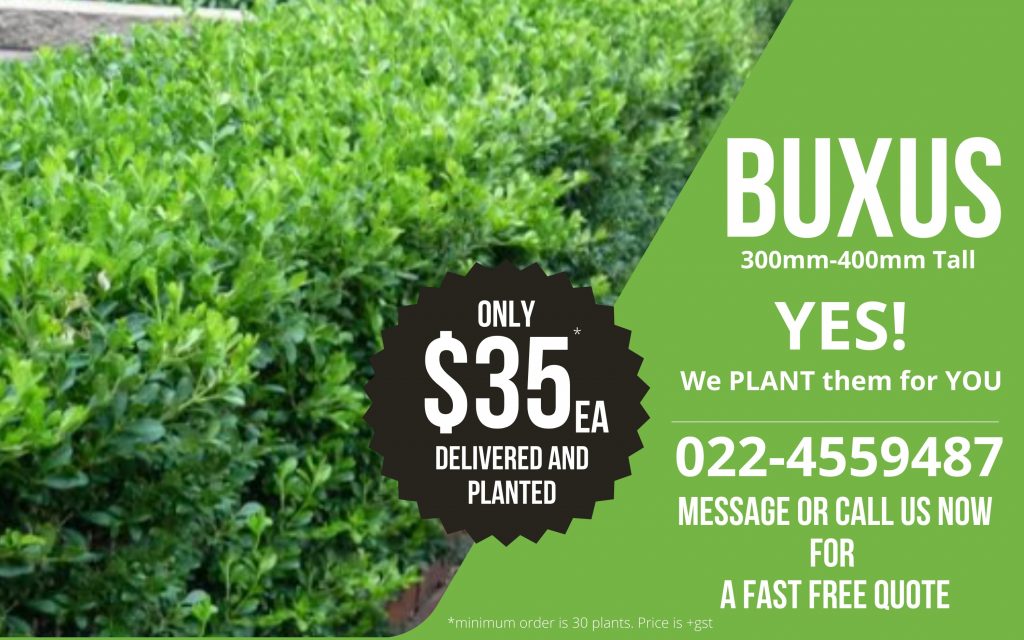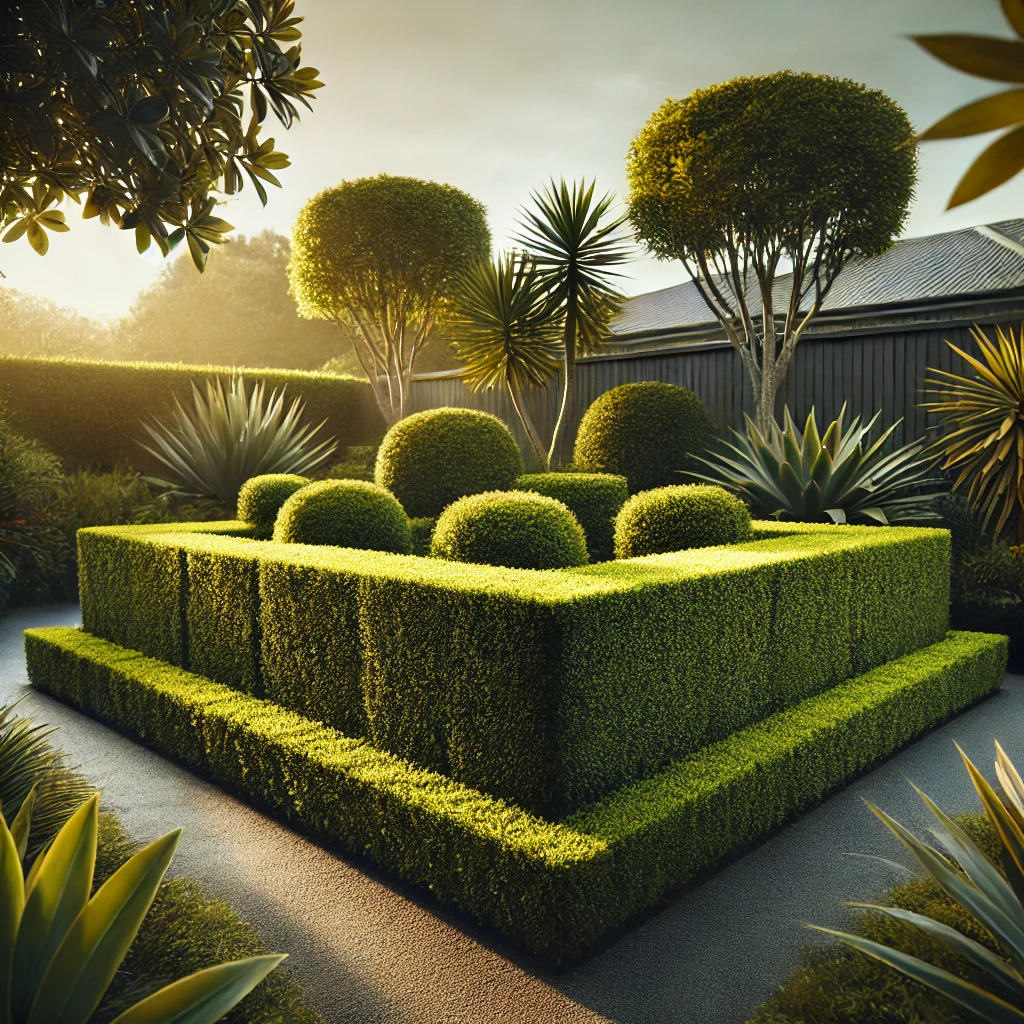Buxus for sale – We supply, deliver and plant this larger grade @ 3 plants per meter for an almost instant hedge

Buxus And The Ancient Civilisations – A Quick History Lesson In The Old World
Many people have seen or had a Buxus growing on their property, but only a few know about this plant and its ancient origins. Within the civilizations, it flourished in and still does. A well-known fact is that the ancient Egyptians planted this hedge back some four thousand years ago.
The Early Origins
Buxus was in Asia, the Americas, and even Africa. The popularity of it has increased and is more popular than ever, especially when you plant boxwood in climates suitable for its growth.
A Hedge Fit For Kings And Queens
In the middle ages, this was the kings and queens’ first choice when landscaping their enormous estates and castles. it is one of the few hedges that grow slowly, making it the perfect choice for shaping into topiary designs. It is also great for mini hedge mazes. You will often see European box heavily planted around entranceways, driveways, garden borders, and long stretches under windows.
Buxus – A True Touch Of Class
Buxus gives any property a touch of aristocratic flair that other hedge varieties can not achieve, hence its popularity. For gardeners, it is a quintessential ingredient for up-market-looking landscapes. Landscapes fit for royalty.
It’s All About The Levels
An essential factor in design and functionality is the varying heights of plants planted within a group of plants. This creates a tiered look with larger hedges at the back, and planted in the front. Roses or other flowering plants planted in the middle were pleasing to the human eye. In countries like Poland, it is a gift or gesture of good health and longevity when shared with loved ones. A practice that is still very much alive today in modern Poland.
The Biggest Problems We See With Buxus Hedges
Buxus is a hardy little hedge. However, most varieties are vulnerable to a type of fungus called “Box Blight.”This can damage the fine woody stems of the plant and affect the leaves as well causing dead patches and small die offs along your otherwise perfect hedge. This is hard to prevent depending where you property is located and affects all but one variety of Buxus. Approximately 2 years ago we noticed this randomly happening to some of our clients plants and after long deliberation we decided to only sell the fairly new strain called Microphillia.
Buy New Disease Free Buxus Hedges
After planting this variety extensively throughout Auckland, we have noticed no problems with our client’s plants being affected by this fungus. As a result, we now only supply and plant the Microphillia variety. We like to plant it once and get it right the first time without returning.
Rising Popularity
Buxus is making a big comeback in modern architecture. Over the past five years, we have been getting more and more inquiries about it from clients. They want something different and more exotic to give a gourmet-looking structure to their gardens and pathways. Homes with extensive plantings always stand out from the crowd, especially with their wandering formations, especially from the roadside. It goes particularly well with star jasmine as an inside flower bed.
Planted By The Best
Many public botanical gardens use Buxus extensively in their displays as they know it is considered a show stopper. However, it is something different you don’t see every day and looks so good when trimmed/shaped up.
Buxus & Water
One of the most common reasons for Buxus dying is the fact that most people do not supply them with enough water. Also many people lay stone chip around them as it looks good but the stones tend to heat up in the sun subsequently heating up the roots and drying the plant out. Buxus surrounded with mulch protects its delicate roots from the sun. Mulch also assists in retaining moisture in the soil for the plant to access when it needs to drink. Please consider these factors when planting and you will end up with a vibrant hedge that will look great as well as standing the test of time.
The Old With The New
Most homeowners are quite surprised to see what such an ancient plant looks like against an ultra modern home. That mix of moderness and antiquity really really works and provides you with a little hedge that will be the envy of your visitors. Buxus by your front door is also rumoured to bring good luck across the threshold into a home, place of work or play so that is just another reason to plant this amazing little hedge.
Be Prepared Or Be Prepared To Fail
So get into it. Do your soil research properly first and be sure to follow the advice mentioned both here and online. Perhaps even start with a small area first and get to know it. Buxus rocks.
How to Grow and Maintain a Perfectly Shaped Box Hedge in NZ
There’s something undeniably charming about a neatly trimmed box hedge. Whether it’s lining a pathway, framing a garden bed, or adding structure to an outdoor space, a box hedge can elevate any garden to a new level of elegance.

In New Zealand, where diverse climates provide both challenges and opportunities for gardeners, growing and maintaining perfectly shaped box hedging requires a bit of know-how and care. The good news is that with the right approach, you can enjoy a lush, green hedge that stays beautiful year-round.
When I first decided to plant box hedging, I was drawn to its versatility and classic appeal. I wanted to create a sense of order in my garden without making it feel too formal, and box hedging seemed like the perfect solution. The idea of shaping and maintaining it was a little intimidating at first, but it turned out to be much easier than I’d expected. Now, my hedge is one of the standout features of my garden, and caring for it has become a genuinely rewarding part of my routine.
The key to growing a perfect box hedging nz starts with choosing the right location. Boxwood thrives in well-drained soil and prefers a spot with plenty of sunlight, although it can tolerate partial shade. In my garden, I planted the hedge along the edge of a sunny path, where it gets plenty of light but is also sheltered from strong winds. This balance has allowed the plants to grow evenly, creating a uniform appearance that’s essential for a neat hedge.
Preparing the soil before planting is just as important. I loosened the soil and mixed in compost to provide a nutrient-rich base for the young plants. This step helped the roots establish quickly, ensuring strong growth from the start. I spaced the plants about 25 centimeters apart, which allowed them to grow into a dense hedge without overcrowding. This spacing has made it easier to shape the hedge and maintain its even look over time.
Watering and feeding your box hedge properly can make a big difference in its health and appearance. When I first planted my hedge, I watered it deeply once a week to encourage the roots to grow deep into the soil.
Now that it’s established, the hedge requires less frequent watering, but I make sure to give it a good soak during dry spells. To keep the foliage vibrant and green, I apply a slow-release fertilizer in early spring and again in late summer. This routine has kept my hedge looking lush and healthy, even during New Zealand’s unpredictable weather.
The most enjoyable part of caring for a box hedge is shaping it. I’ll admit, the first time I picked up the hedge shears, I was nervous about making a mistake. I started by trimming just a little at a time, focusing on creating straight lines and even edges.
Over time, I’ve gained confidence, and shaping the hedge has become one of my favorite gardening tasks. I usually trim the hedge twice a year, once in early summer and again in late winter, to maintain its shape and encourage bushier growth.
One of the tricks I’ve learned is to use stakes and string as a guide when trimming. This simple tool has helped me achieve a clean, uniform look, especially when working on longer sections of the hedge. For curves or more intricate shapes, I rely on regular visual checks, stepping back frequently to ensure the symmetry looks right. It’s a process that requires a bit of patience, but the results are well worth the effort.
Box hedges are surprisingly resilient, but they can face challenges like pests and diseases. One year, I noticed some yellowing leaves on my hedge and discovered it was due to root rot caused by overwatering. Adjusting the watering schedule and improving the drainage solved the problem, and the hedge quickly bounced back.
Scale insects can also be an issue, but I’ve found that spraying the affected areas with a mix of water and dish soap works wonders. Keeping the hedge healthy through proper feeding and watering has also helped prevent these problems from recurring.
One of the things I love most about box hedging is how it transforms the look and feel of a garden. My hedge frames the main pathway, creating a sense of order and elegance that visitors always comment on.
A friend of mine has used box hedging nz to define the edges of her vegetable garden, and it adds a lovely touch of formality to an otherwise casual space. Another neighbor has shaped her box hedge into a series of rounded mounds, which create a playful, sculptural effect. The versatility of box hedging means there’s no limit to what you can create.
For New Zealand gardeners, box hedges are particularly well-suited to the climate. They handle the mild winters and moderate summers beautifully, making them a reliable choice for gardens across the country. Whether you’re in the cooler South Island or the warmer North Island, a box hedge can thrive with the right care.
Maintaining a perfectly shaped box hedge isn’t just about achieving a specific look—it’s also about creating a space that feels special. For me, the process of shaping and tending to my hedge has become a meditative practice, a chance to slow down and connect with my garden.
And the result, a lush, green hedge that stays beautiful year-round brings a sense of pride and joy every time I step outside.
If you’re considering adding a box hedge to your garden, I can’t recommend it enough. With a little effort and attention, you can create a feature that not only enhances your outdoor space but also becomes a source of lasting satisfaction. Whether you’re aiming for formal elegance or something a bit more whimsical, a box hedge is a timeless choice that’s always in style.
Box Hedging Trends in NZ: Adding Structure and Elegance to Your Garden
Box hedging has long been a staple in gardens around the world, known for its versatility and timeless charm. In New Zealand, this classic landscaping feature is experiencing a revival, with gardeners and designers reimagining its use in fresh and exciting ways.
From traditional formal gardens to modern minimalist landscapes, box hedging is proving to be the perfect solution for adding structure, elegance, and year-round greenery to outdoor spaces.

When I first moved into my home, I was looking for a way to bring order to my slightly chaotic garden. The mix of wildflowers and sprawling greenery was lovely, but it lacked definition. Box hedging nz seemed like an obvious choice, offering clean lines and the ability to shape the garden in a way that felt intentional.
What I didn’t expect was how much it would transform the space, making it not only more structured but also more inviting.
One of the biggest trends in New Zealand right now is using box hedging to frame pathways and define outdoor living areas. This trend isn’t new, but what’s exciting is the creative ways it’s being done. I’ve seen box hedges used to create curved borders around patios, giving the space a softer, more organic feel.
In a friend’s garden, she used low box hedging to create geometric patterns, turning her lawn into a kind of living artwork. It’s amazing how a simple hedge can make such a dramatic statement.
Box hedging is also being used to highlight and enhance New Zealand’s native plants. Pairing the structured greenery of box hedging with the bold, sculptural forms of plants like flax or cabbage trees creates a striking contrast. In my own garden, I’ve planted small box hedges around a bed of native grasses, and the result is a balance of order and wildness that feels very much in tune with the Kiwi landscape.
Another popular trend is the use of box hedging in smaller urban gardens. In compact spaces, a well-maintained hedge can act as a natural screen, providing privacy without feeling imposing.
I recently visited a friend’s city courtyard, where she had used box hedges to create a sense of enclosure around her seating area. The lush greenery softened the hard lines of the surrounding walls and made the space feel much more tranquil.
What makes box hedging so appealing is its adaptability. It can be shaped into almost any form, from low borders to tall, imposing walls. This versatility allows it to fit seamlessly into gardens of all styles, from traditional English-inspired designs to sleek, modern landscapes. In my neighborhood, one house features a series of rounded box hedges that look like green bubbles floating across the lawn, while another has tall, angular hedges that create a dramatic, contemporary feel.
Maintaining box hedging is surprisingly straightforward, which adds to its appeal. In my experience, the key is regular trimming to keep the shape neat and encourage dense growth. I usually prune my hedges twice a year, once in late winter and again in mid-summer.
Using sharp shears and taking the time to step back and assess the shape as I go ensures a professional-looking finish. Adding a slow-release fertilizer in spring helps keep the foliage vibrant and healthy.
Box hedging isn’t just about aesthetics—it also offers practical benefits that are being embraced by more and more gardeners in New Zealand. A well-placed hedge can act as a windbreak, protecting more delicate plants from strong gusts.
It can also create microclimates, offering shade and shelter that can be especially valuable during the hot summer months. In my garden, I’ve noticed that the plants near my box hedge are thriving, thanks to the protection it provides.
One of the most exciting aspects of box hedging is how it can be used to personalize a garden. I’ve seen hedges shaped into spirals, pyramids, and even animal forms, adding a playful touch to otherwise formal spaces.
A local café near me has used box hedges to create low partitions between outdoor tables, and it’s become a talking point among visitors. These creative applications show that box hedging isn’t just a traditional choice—it’s a dynamic and versatile tool for garden design.
Incorporating box hedging into your garden doesn’t have to be daunting. Whether you’re planting a full hedge or simply adding a few small sections, the key is to start with healthy plants and give them a strong foundation. Preparing the soil with compost and ensuring good drainage will set your hedges up for success. In my case, I started with small box plants and watched with satisfaction as they grew into a seamless green border over time.
As I sit in my garden, enjoying the clean lines and vibrant greenery of my box hedges, I’m reminded of why they’ve been such a popular choice for centuries. They bring a sense of structure and harmony to the garden while allowing for endless creativity and personalization.
In New Zealand, where gardening often reflects a blend of tradition and innovation, box hedging fits perfectly, offering a timeless yet adaptable solution for any outdoor space.
If you’re considering adding box hedging to your garden, now is the perfect time to embrace this enduring trend. Whether you’re creating a formal border, framing a feature, or experimenting with bold shapes, box hedging offers a way to add structure, elegance, and a touch of magic to your outdoor space.
